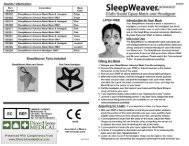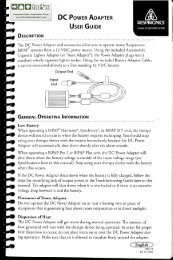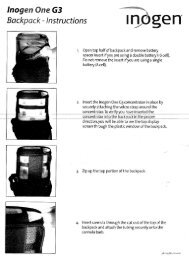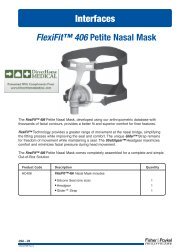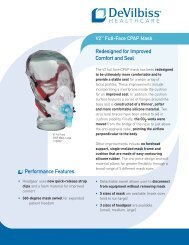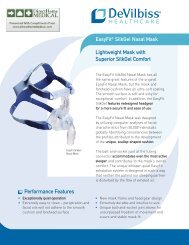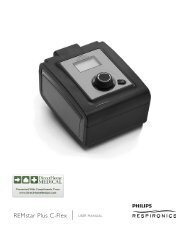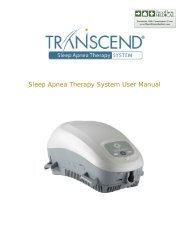SleepStyle HC254 Auto CPAP User Guide - Sleep Restfully, Inc.
SleepStyle HC254 Auto CPAP User Guide - Sleep Restfully, Inc.
SleepStyle HC254 Auto CPAP User Guide - Sleep Restfully, Inc.
Create successful ePaper yourself
Turn your PDF publications into a flip-book with our unique Google optimized e-Paper software.
1. SYMBOL DEFINITIONS<br />
Type BF<br />
Applied Part<br />
2. INTENDED USE<br />
ATTENTION<br />
Consult accompanying<br />
documents<br />
Drip-proof<br />
Alternating<br />
Current<br />
A - 2<br />
Class ll<br />
Double-insulated<br />
The <strong><strong>Sleep</strong>Style</strong> 200 <strong>Auto</strong> Series <strong>CPAP</strong> Humidifier is for use on adult patients for the treatment of Obstructive <strong>Sleep</strong> Apnea (OSA).<br />
The device is for use in the home or sleep laboratory.<br />
3. WARNINGS, CAUTIONS, CONTRAINDICATIONS<br />
Notes<br />
• This manual refers to the <strong><strong>Sleep</strong>Style</strong> 200 <strong>Auto</strong> Series unit as<br />
"the device".<br />
• If required to use <strong>CPAP</strong> or <strong>Auto</strong> <strong>CPAP</strong> by a referring physician<br />
you should use your device every time you sleep. Should your<br />
device stop working for any reason, contact your healthcare<br />
provider immediately.<br />
• The user of this system shall have sole responsibility and liability<br />
for any injury to persons or damage to property resulting from<br />
operation of the device which is not in accordance with the<br />
operating instructions supplied.<br />
• The device should only be used with masks, connectors and<br />
delivery tubes recommended by Fisher & Paykel Healthcare,<br />
your physician or sleep specialist.<br />
• We recommend use of Fisher & Paykel Healthcare interfaces to<br />
ensure true data accuracy.<br />
• Under normal operating conditions the air supplied by the device<br />
will not exceed 105.8ºF (41ºC).<br />
• Refer all repair and maintenance to Fisher and Paykel Healthcare.<br />
• Only insert or remove the SmartStick when the device is in<br />
standby mode or not connected to mains power.<br />
• SmartStick should only be removed when downloadable data<br />
is required by your physician or sleep specialist.<br />
• To avoid data loss do not remove the SmartStick from the<br />
device while the light is flashing.<br />
• To avoid damage and data loss, transport the SmartStick in<br />
the transportation case provided.<br />
• Use only Fisher & Paykel Healthcare-supplied SmartSticks.<br />
• Do not operate the device without the SmartStick cap secured<br />
over the SmartStick port.<br />
• Do not operate the device without the cover over the serial port<br />
adapter.<br />
WARNINGS<br />
To avoid electric shock from your device, do not:<br />
• Operate the device if the power cord or plug is damaged.<br />
• Operate the device if it has been dropped in water.<br />
• Plug the device into the power socket if it is wet.<br />
• Clean the device while connected to the power socket.<br />
• Store or use the device where it can tilt, fall or be pulled into<br />
water. If water has entered the unit enclosure, disconnect<br />
the power cord and discontinue use. Seek advice from your<br />
healthcare provider.<br />
To avoid choking or inhalation of a foreign body:<br />
• Never place any object into any opening of the tube.<br />
• Ensure the air filter is fitted during device use.<br />
To ensure optimal therapy, do not:<br />
• Insert the SmartStick into any PC that does not have<br />
PerformanceMaximizer software installed. Changing the<br />
directories on the SmartStick or attempting to view the data<br />
collected without the correct software will result in all data stored<br />
on the SmartStick being lost; therefore therapy follow-up can<br />
not be conducted.<br />
• Operate the device if dropped or damaged.<br />
• Operate the device if not working properly.<br />
• Adjust the pressure. Pressure must only be adjusted by a<br />
healthcare professional.<br />
• Operate the device if the tube has been damaged with holes,<br />
tears or kinks.<br />
• Block the exhaust flow on the interface.<br />
• Use the mask if the unit is not turned on or operating properly.<br />
Standby<br />
93/42/EEC<br />
Class IIb<br />
To avoid burns, do not:<br />
• Fill the chamber with boiling water.<br />
• Touch the exposed heater plate or chamber base.<br />
To avoid the risk of fire while using oxygen, do not:<br />
• Turn oxygen flow on when the device is not operating; this can<br />
lead to accumulation of oxygen within the device.<br />
• Locate the device in a position where ventilation around the<br />
device is restricted.<br />
• Use oxygen while smoking or in the presence of an open flame.<br />
• Use any materials which will burn in air or ignite easily at high<br />
oxygen concentration.<br />
• Keep any source of ignition by the product. To avoid ignition it is<br />
preferable to keep all sources of ignition out of the room where<br />
supplemental oxygen is being used.<br />
• Keep oxygen regulators, cylinder valves, tubing, connections<br />
and all other oxygen equipment near oil, grease or greasy<br />
substances. Spontaneous and violent ignition may occur if these<br />
substances come into contact with oxygen under pressure.<br />
Other:<br />
• Place the device on a level surface lower than head height to<br />
prevent water entering the tubing. If water does enter the tubing<br />
drain excess condensate. Water in the tubing may result in<br />
aspiration.<br />
• The device is intended to be used with <strong>CPAP</strong> masks and<br />
connectors that have exhaust flow holes to allow continuous<br />
flow of air out of the mask. When the device is turned on and<br />
operating properly new air flushes exhaled air out of the mask<br />
through the exhaust flow holes. At low <strong>CPAP</strong> pressures and in<br />
the event of power failure or machine malfunction remove the<br />
mask immediately, as flow through the mask may be insufficient<br />
to clear all exhaled gas and CO 2 rebreathing may occur which<br />
can be hazardous.<br />
• Failure to select the correct altitude level (for any given location)<br />
will have an adverse effect on delivered pressure.<br />
CAUTIONS<br />
To prevent water damage to your device:<br />
• Remove the humidification chamber from the device before filling.<br />
• Empty water from the chamber before transporting the device. If<br />
the device is required to be handled with water in the chamber,<br />
avoid tilting the device to prevent water entering its enclosure.<br />
Other:<br />
• To prevent damage to your PC, only operate the device if<br />
it is connected to a PC via an isolated serial port adapter<br />
(900HC236).<br />
• To prevent airway irritation, do not use the device when room<br />
temperature exceeds 95°F (35°C).<br />
CONTRAINDICATIONS<br />
• Research indicates the following pre-existing conditions may<br />
contraindicate the use of positive pressure for some patients:<br />
pneumothorax, bullous lung disease, pneumocephalus,<br />
cerebrospinal fluid leak, recent cranial surgery or trauma,<br />
abnormalities of the cribriform plate, pathologically low blood<br />
pressure, middle ear infections, perforated ear drum, sinusitis, or<br />
dehydration.<br />
• This auto adjusting device is not suitable for use in patients<br />
with congestive heart failure, obesity hypoventilation syndrome,<br />
central sleep apnea, respiratory failure, COPD or in patients<br />
whose upper airways are bypassed.<br />
• Please contact your physician if you have any questions<br />
concerning your therapy.




